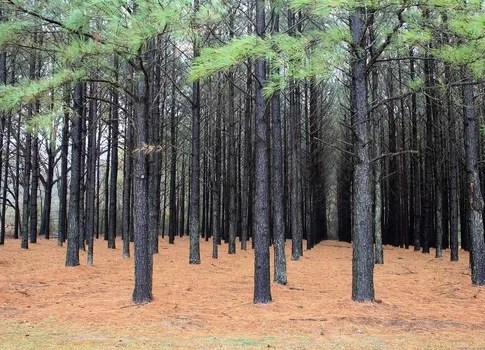In the face of a changing climate and increasing demand for sustainable resources, plantation forestry has emerged as a significant player in the global effort to balance economic needs with environmental stewardship.
This practice, which involves the cultivation of trees on managed plantations for commercial purposes, has grown in prominence due to its potential to provide renewable resources, enhance carbon sequestration, and alleviate pressure on natural forests.
In this blog, we will explore the benefits, challenges, and future prospects of plantation forestry.
What is Plantation Forestry?
Plantation forestry refers to the practice of growing trees in a planned and systematic manner on designated lands. Unlike natural forests, which develop without direct human intervention, plantation forests are carefully managed to optimize growth, yield, and quality of timber and other forest products. Common species used in plantation forestry include fast-growing trees like eucalyptus, pine, and acacia, which are often chosen for their rapid growth rates and suitability for various climates and soil conditions.
Benefits of Plantation Forestry
- Sustainable Resource Production: Plantation forests provide a steady supply of timber, pulp, and other forest products, reducing the need to harvest from natural forests. This sustainable approach helps meet the global demand for wood and paper while conserving biodiversity-rich natural forests.
- Carbon Sequestration: Trees absorb carbon dioxide from the atmosphere as they grow, making plantation forests valuable tools in the fight against climate change. Well-managed plantations can sequester significant amounts of carbon, contributing to global efforts to reduce greenhouse gas emissions.
- Economic Opportunities: Plantation forestry can create jobs and stimulate economic development in rural areas. It provides income for landowners, supports local industries, and contributes to national economies through the export of forest products.
- Ecosystem Services: Besides timber production, plantation forests offer various ecosystem services, such as soil stabilization, water regulation, and habitat provision for wildlife. They can also serve as buffer zones that protect natural forests from agricultural encroachment and urban development.
Challenges of Plantation Forestry
- Monoculture Concerns: Many plantation forests consist of single-species stands, or monocultures, which can be vulnerable to pests, diseases, and environmental changes. This lack of biodiversity can lead to ecological imbalances and reduced resilience compared to natural forests.
- Land Use Conflicts: The establishment of plantations sometimes leads to conflicts over land use, especially in regions where land tenure is disputed or where plantations displace traditional land uses such as agriculture or indigenous land rights.
- Environmental Impact: Intensive management practices, such as the use of fertilizers, pesticides, and irrigation, can have negative environmental impacts. Poorly managed plantations can lead to soil degradation, water pollution, and loss of native vegetation.
- Social Issues: The benefits of plantation forestry are not always equitably distributed. In some cases, large-scale plantations have been associated with land grabbing, displacement of local communities, and poor working conditions.
Future Prospects of Plantation Forestry
To maximize the benefits and mitigate the challenges of plantation forestry, several strategies are being developed and implemented:
- Diversification: Incorporating a variety of tree species in plantations can enhance biodiversity, improve resilience to pests and diseases, and provide a wider range of products and ecosystem services.
- Sustainable Management Practices: Adopting sustainable forestry practices, such as reduced-impact logging, integrated pest management, and agroforestry systems, can minimize environmental impacts and enhance the ecological and social benefits of plantations.
- Certification and Standards: Certification schemes like the Forest Stewardship Council (FSC) and the Programme for the Endorsement of Forest Certification (PEFC) promote responsible forest management by setting standards for environmental, social, and economic sustainability.
- Community Involvement: Engaging local communities in plantation forestry projects can ensure that the benefits are shared and that traditional knowledge and practices are respected. Participatory approaches can also help resolve land use conflicts and improve social outcomes.
Plantation forestry holds great promise as a sustainable solution to meet the growing global demand for forest products while conserving natural forests and contributing to climate change mitigation. By addressing the challenges and adopting best practices, plantation forestry can play a crucial role in the transition to a more sustainable and resilient future. As we move forward, it is essential to balance economic objectives with environmental and social considerations to ensure that plantation forestry truly contributes to a greener and more equitable world.
Related stories
Forestry Corp Admits Guilt Destroyed Vital Trees
Endangered Greater Glider Killed in Yarra Ranges National Park
The Battle for Wild Cattle Creek State Forest
Illegal Logging in Styx River State Forest Must Stop
Biodiversity Appreciation: Insights from the Community
MPs $64,000 question – Save Koalas or logging trucks
NSW Forestry Corp fines exceed $1,000,000 since 2019 fires
Forestry Corp NSW forms a special police branch
Citizen Scientists Take Action in Bulga State Forest
Logging Threatens Koala Habitat Despite Community’s Pleas
EPA stops logging at Flat Rock State Forest
EPA’s Stop Work Order extended in Tallaganda State Forest
Greater Glider heading for extinction
NSW Forestry Corp have a fight on their hands to Save Bulga Forest
Midcoast Council Votes to Save Bulga Forest on Biripi Country
The Great Koala National Park without any Koalas
Is AUKUS damaging Australia’s relationship with China?
Era of Change: 1960s-70s Revolution & Welcome to Country
Please comment below or visit our advertisers, if this is interesting to you. ChatGPT assisted. Thanks for visiting our growing magazine.




